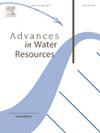基于梯度的浅水二维降雨径流模型空间分布参数估计
IF 4.2
2区 环境科学与生态学
Q1 WATER RESOURCES
引用次数: 0
摘要
本文提出了一种基于梯度的二维浅水水力模型分布式入渗参数反演方法。介绍了降雨和入渗质量源项在DassFlow直接反演建模平台上的实现及其与实验数据的验证。通过综合实验,展示了通过水力特征分析、随机参数空间探索和分布或多变量控制的反建模来推断入渗参数所带来的反问题的复杂性。为了解决稀疏观测背景下的空间不确定性,采用空间约束来寻求均匀区域或斑块形式的入渗参数,共享可用土壤图的分辨率。它们还以基于土壤传递函数的参数模型的形式引入,用于降低反问题的维数并对推断的分布参数施加空间相干性。这种直接模型的升级可以将物理描述符映射所携带的参数分布的先验知识集成到同化过程中,从而提供空间正则化效果。通过求解一个高维反问题,给出了不正则化的全分布参数化的推理结果。该方法适用于法国东南部的rsamal Collobrier水文观测站内的实际集水区,该观测站由INRAE监测。在包含高分辨率地形和降雨数据的模型中,吸收了真实的下游流量观测数据来推断分布的入渗参数图,包括通过区域化的土壤转移函数。这导致有效入渗模型参数的推断,提供了更好的拟合实际流动观测。本文章由计算机程序翻译,如有差异,请以英文原文为准。
Gradient-based estimation of spatially distributed parameters of a shallow water 2D rainfall-runoff model
This contribution presents a gradient-based inverse modeling approach for the inference of distributed infiltration parameters in a 2D shallow water hydraulic model. It describes the implementation of rain and infiltration mass source terms in the DassFlow direct-inverse modeling platform and their validation against experimental data. Synthetic experiments are used to showcase the complexity of the inverse problems posed by the inference of infiltration parameters through hydraulic signature analysis, stochastic parameter space exploration and inverse modeling with distributed or multi-variate controls. To address spatial uncertainty in the context of sparse observations, spatial constraints are imposed to sought infiltration parameters in the form of homogeneous areas, or patches, sharing the resolution of available soil maps. They are also introduced in the form of a parameter model based on pedotransfer functions, which are used to reduce the dimensionality of the inverse problem and impose spatial coherence to the inferred distributed parameters. This upgrade of the direct model enables integrating a priori knowledge of parameter distribution carried by physical descriptor maps into the assimilation process, hence providing a spatially regularizing effect. Inference results for a fully distributed parametrization without regularization, which is achieved by solving of a high-dimensional inverse problem, are also presented. The methodology is applied to real catchments within the Réal Collobrier hydrological observatory in southeastern France, monitored by INRAE. In a model containing high-resolution topography and rain data, real downstream discharge observations are assimilated to infer distributed infiltration parameters maps, including through regionalized pedotransfer functions. This leads to the inference of effective infiltration model parameters that provide a better fit to real flow observations.
求助全文
通过发布文献求助,成功后即可免费获取论文全文。
去求助
来源期刊

Advances in Water Resources
环境科学-水资源
CiteScore
9.40
自引率
6.40%
发文量
171
审稿时长
36 days
期刊介绍:
Advances in Water Resources provides a forum for the presentation of fundamental scientific advances in the understanding of water resources systems. The scope of Advances in Water Resources includes any combination of theoretical, computational, and experimental approaches used to advance fundamental understanding of surface or subsurface water resources systems or the interaction of these systems with the atmosphere, geosphere, biosphere, and human societies. Manuscripts involving case studies that do not attempt to reach broader conclusions, research on engineering design, applied hydraulics, or water quality and treatment, as well as applications of existing knowledge that do not advance fundamental understanding of hydrological processes, are not appropriate for Advances in Water Resources.
Examples of appropriate topical areas that will be considered include the following:
• Surface and subsurface hydrology
• Hydrometeorology
• Environmental fluid dynamics
• Ecohydrology and ecohydrodynamics
• Multiphase transport phenomena in porous media
• Fluid flow and species transport and reaction processes
 求助内容:
求助内容: 应助结果提醒方式:
应助结果提醒方式:


